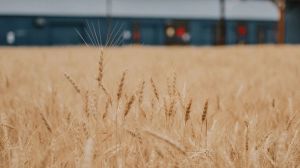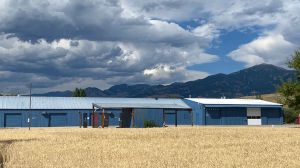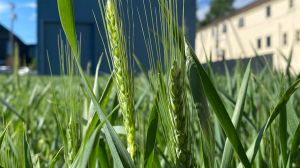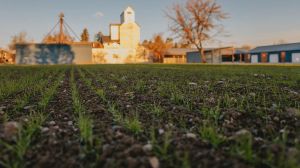
Agnes Denes, Wheatfield—A Confrontation, 1982 courtesy the artist and Leslie Tonkonow Artworks + Projects. Photo: Agnes Denes
Overview
As part of its 2024 exhibition, The Lay of The Land, Tinworks presented a significant new work by artist Agnes Denes. Wheatfield - An Inspiration. The seed is in the ground.
A groundbreaking, internationally recognized figure, and one lauded as one of the first ecological artists, Denes engages science, philosophy, math, linguistics, technology, engineering, urban planning, music, and poetry in visionary artworks that explore environmental issues and humanity’s impact on the planet. One of her most celebrated works, Wheatfield—A Confrontation, was planted in New York City in 1982. In the forty years since that installation, this is the first time Denes has accepted an invitation to reposition the work in another American context.
Reimagining Wheatfield in Bozeman was particularly compelling because of the significant role of wheat in the history and economy of Montana, the increasing loss of farmland in the Gallatin Valley, and the opportunity to devote the field at Tinworks to public art installations. The scope of Wheatfield - An Inspiration demonstrated Tinworks' commitment to ambitious projects that provide the space and support for artists and the public to directly engage in contemporary issues and the complex challenges of our time. As Denes explains, “The Wheatfield is hope. There is renewal in the seed. We are planting hope.”
How You Can Take Part
Denes invites the Bozeman community to participate in the artwork this spring by planting wheat in any available land, creating a city-wide wheatfield in solidarity with Wheatfield - An Inspiration.
We invite you to become a part of the art now by completing Questionnaire, an artwork first begun in 1979 in which Denes poses questions about the most pressing issues facing humanity, inviting answers and solutions from the community.
2024 Exhibition Season
Agnes Denes' Wheatfield - An Inspiration. The seed is in the ground was the touchstone of Tinworks Art’s 2024 exhibition season, The Lay of the Land, which also featured work by five artists inspired by the land of the American West.
With an intergenerational mix of established and emerging artists, iconic work and newly commissioned installations, The Lay of the Land explored how land in the west is represented. The artworks included connected to land and place through their physical materiality—wheat, sediment, soot, clay, the sound of passing trains—and subject matter—the natural or industrial forces that have shaped the land of the west and depictions of western places shaped by memory or technology.
Wheatfield - A Confrontation: Battery Park Landfill, Downtown Manhattan
About the Artist
A groundbreaking, internationally acclaimed figure in the conceptual, environmental, and ecological art movements that emerged in the 1960s and 70s, Agnes Denes continues to defy easy classification. She engages science, philosophy, math, linguistics, technology, engineering, music, and poetry in visionary works that explore environmental consciousness and humanity’s impact on the planet. One of her most recognized and influential works is Wheatfield—A Confrontation, from 1982, in which Denes planted a two-acre field of wheat in prime New York real estate in Lower Manhattan. It is widely considered to be one of the first public ecological artworks. Her drawings, prints, and photographs are in the collections of major museums around the world. Denes has received numerous prestigious awards, honorary doctorates, and fellowships, and has exhibited extensively over the past fifty years. Born in Budapest in 1931, Denes lives and works in New York.
From the Artist
Planting Wheat in Solidarity
Thank you for being a part of the art by planting wheat in solidarity with Agnes Denes' Wheatfield.
If you've picked up seeds from Tinworks Art at Gallatin County Earth Day Festival, a Give Big event, or at our site at 719 N Ida, we ask that you first fill out the short sign-up via the link below.
Partners
A special thanks to our partners: Abundant Montana; Anderson School; Bozeman Public Library; Gallatin Valley Farm to School; Gallatin Valley Food Bank; KGVM; KGLT; Montana Science Center; MSU, College of Art and Architecture; MSU, Department of Plant Sciences and Plant Pathology; MSU, Hilleman Scholars; SAV DIgital Environments; The Extreme History Project; and Wild Crumb Bakery.








